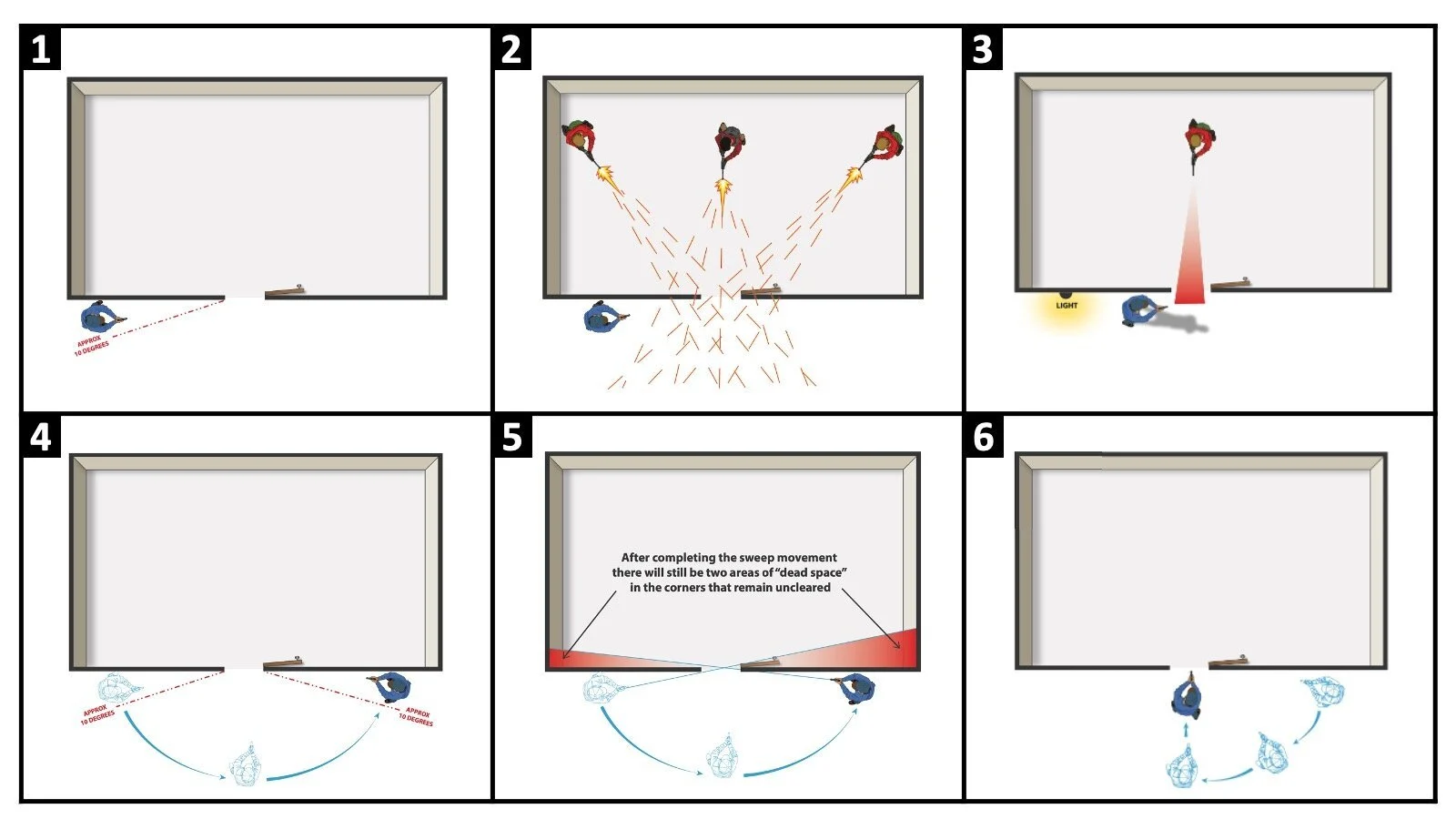Singleton CQB: Shallow Entry Technique (Part 1 of 2)
This short article is taken from our Single-Person CQB Online Course and companion book. It provides step-by-step instructions for conducting one of the many techniques taught in the course: the “shallow entry” technique, also sometimes referred to as limited penetration. We will explain this technique in two articles. This article explains the first half of the technique. We welcome your reactions, comments and ideas on our Facebook page and if you like the article, click below to check out our free preview of the Single Person CQB Online Course.
Introduction to Shallow Entry (Limited Penetration)
A key difference between team operations and single-person operations is that as a single-person, there are many cases when you will not want to penetrate too far into a room. You may want to get into the room quickly to avoid greater exposure in a hallway, but you will want to stay close to the door so you can escape the way you came should more adversaries come at you from adjacent rooms.
The shallow entry techniques (sometimes called “limited penetration” techniques) are designed to prevent you from becoming over-committed or trapped deep in a target room. In single-person operations, it is often better to stay closer to a door so you can quickly move through it to avoid threats coming from either direction. Don’t commit too far into the room and cut off your own route of escape. However, still observe the rule of keeping several meters between you and the door to avoid getting hit by indiscriminate fire.
If there is a lot of furniture and uncleared dead space in the room, the shallow entry can make you vulnerable since you have not gone deep enough to see if anyone is hiding behind the furniture. In this situation, you might want to penetrate deeper and clear the entire room using the deep entry technique described later on.
It is also advisable to go on and complete the deep entry if you plan on staying in the room for any length of time. In general, the shallow entry is most useful if you want to quickly enter and clear the room to momentarily get out of an exposed area or hallway. Once you are ready to keep moving, you will exit the room and move along to clear the next room.
The shallow entry techniques call for a 180-degree kneeling pivot movement. If you have trouble conducting this movement it is possible to execute the shallow entry techniques without kneeling, though kneeling helps reduce your risk of getting shot by an adversary hiding in the corner of the room.
TECHNIQUE: Shallow Entry (Center-Fed, Open Door) Part 1 of 2
Refer to the numbered images above as you read the instructions for how to conduct the shallow entry technique. Note that this is only the first half of the technique. We will present the remaining steps for the technique in our next article. Also, for the sake of space in this article, the images have been condensed but they are larger in the full course/book.
STEP 1: Approach the Door
As you approach an open door from the outside of the room, begin by positioning yourself close to the wall, several meters from the doorway. Stay close to the wall but avoid touching or bumping into the wall because doing so will make noise and might also increase your chances of getting shot, since bullets tend to travel along walls.
STEP 2: Avoid Indiscriminate Fire
Staying away from the doorway is also important. Many adversaries, especially terrorists with automatic weapons, will not fire single, aimed shots but will rather spray bullets indiscriminately in the direction of any noise or potential threat. This spray of bullets will generally form an arc several meters wide. If you stay close to a door and the adversary detects you, you might get hit with a barrage of bullets coming through the doorway and the walls surrounding the doorway. Remember, that most interior walls are not bulletproof and the chances of getting shot through a wall are very high. By staying several meters back from the door, you minimize the chances of getting hit by indiscriminate fire.
STEP 3: Watch Your Shadow
Staying back from the door also minimizes your chances of detection, especially in terms of shadows created by interior lights. Most buildings have multiple light sources in each room or hallway. This means that when you come close to an open door, someone standing inside the room can most likely see your shadow moving across the floor behind the opening. Keep your distance from the door and try to remain aware of your shadow as you move.
STEP 4: Conduct “Sweep” Movement
The next step is to sweep out in a wide arc, keeping your weapon focused on the doorway. Keep your distance from the door and move all the way across until you are positioned close to the wall on the opposite side of the door. Your aim is to visually clear the room as quickly as possible to identify any threats inside and possibly draw those threats out of the room. When executing the sweep, move in an arc as fast as you can while keeping your weapon relatively steady and taking care not to trip. You are giving up some weapon accuracy in order to minimize exposure and make yourself less of a target. By moving quickly along the arc it will be quite difficult for an adversary to shoot you since you will be exposed for only a fraction of a second. With practice you will also learn to engage targets as you sweep across the door. Once you have completed your sweep, you can conduct additional sweeps if needed to check the room more carefully.
STEP 5: Recognize “Dead Space”
Once you reach the opposite side of the door, keep your distance since the adversary might fire indiscriminately in the direction of the doorway. Keep your weapon at the ready, focused on the door. One of the main advantages of the sweep technique is that it can draw adversaries out of the room, directly into your sights as you wait covering the door. So, once the sweep is complete, you can wait momentarily to draw adversaries out or listen to hear movement coming from inside the room. However, do not wait too long since the longer you stay in one place the easier it is for adversaries to maneuver against you. The task of clearing the room is not yet complete because even if your sweep revealed no threats, there will still be two slices of “dead space” that are not yet clear in each corner of the target room.
STEP 6: Conduct Half-Sweep and Move Towards the Door
It is now time to move towards the door to conduct the shallow entry. First, conduct a half-sweep in the opposite direction you just moved until you are facing the open door. Then, move directly towards the door. Moving directly towards the door will give you the best observation into the room. You will also notice that as you get closer, more and more of the room will come into view as the angle of your vision widens. This means you will be exposing yourself to more of the room little-by-little as opposed to all at once. Stay alert for threats as you approach.
This completes the first half of the “shallow entry” technique. We will finish explaining the technique in the next article. We hope you found the short article useful and once again we welcome your reactions, comments or suggestions on our Facebook page where we frequently hold constructive discussions on tactics with people from various tactical backgrounds and experience levels. Also, click below if you would like to check out the first two modules of our online course for free.


